
2022 年 11 月 16 日
The 2023 Supply Chain Planning Playbook - Predictions & Advice From Global Logistics Experts
It’s hard to believe that 2023 marks three years since the start of the COVID-19 pandemic and the slew of supply chain disruptions it triggered globally. As businesses of all sizes continue to navigate economic uncertainty, shipping delays, and supply chain bottlenecks, successful brands have learned that flexibility and visibility are the keys to weathering unexpected supply chain chaos.
The new year is the perfect opportunity to rethink your supply chain strategy, but where should you start? In this “2023 Supply Chain Planning Playbook,” we’ve gathered timely and actionable predictions and planning tips from global experts to help you prepare for what 2023 may hold. We want to give a huge thank you to all the experts that weighed in with their valuable insights and advice.
"Since logistics is a system of systems, when out of alignment, there are repercussions throughout the supply chain. The largest challenge in 2023 will be navigating continued global disruption while supply chains are reshaped."
- Lisa Anderson President, LMA Consulting Group, Inc.
Dive into expert predictions on what you should prioritize during planning, the biggest logistics challenges to expect, ways to optimize for every opportunity, and the 10 key trends that will shape the future of global trade.
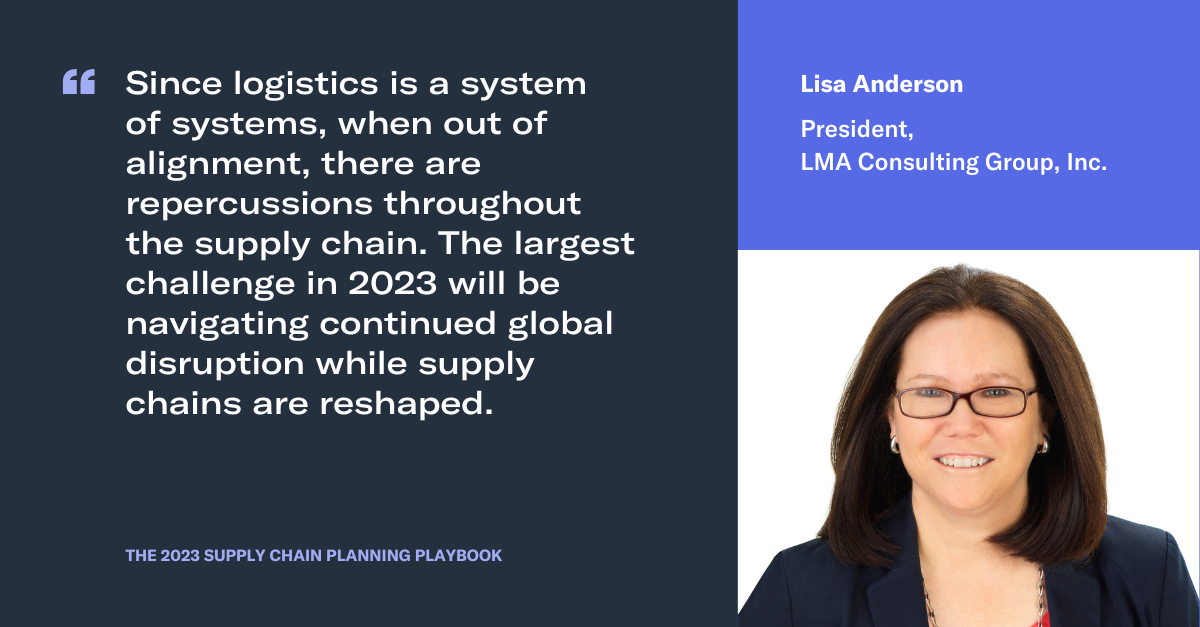
1. Taking a Closer Look - Analyzing the State of Your Supply Chain
Today’s complex supply chains comprise inventory in motion with stakeholders, goods, and systems interspersed around the world. Realizing the full impact that comes with aligning your shipping systems will position your brand for long-term stability and success.
While a lot of recent buzz has been about robotics and automation, better and newer technology and more visibility have been the most significant drivers of competitive advantages. Retail and e-commerce brands in particular are increasingly investing in better shipment tracking technology, ERPs, and forecasting tools.
"The Frankenstein approach of supply chain operations executing on multiple cobbled-together systems and processes will continue to be a significant bottleneck. Visibility at a SKU level is a requirement from placing the order to final delivery."
- Bernie Hart, VP, Customs & Trade Business Development, Flexport
Whether businesses are shipping fast-moving consumer goods for the first time or have established trade lanes, they can benefit from reliable, SKU-level data in real time. In order to use that data effectively, your entire supply chain must function as an efficient, well-oiled machine and quickly adapt to new and existing challenges.
Breaking down inefficiencies is especially important to combat market volatility. We expect a turbulent market in 2023 as demand and supply try to find an equilibrium, all with a potential backdrop of a worldwide recession.
"Shippers had to be reactive to unprecedented market conditions where asset owners held 100% of the leverage. Now they can reassess their supply chain strategy AND the freight forwarders who are best able to serve them in the future."
- Neel Jones Shah, EVP of Air Strategy & Carrier Development, Flexport
As brands continue to grapple with global instability, material shortages, and geopolitical shifts, macroeconomic risk management will become an integral part of planning tools and processes. Now is the time to question if you have visibility into potential risks, strategies for mitigation, and flexible compliance requirements that can grow with your business in 2023.
"Plan for continued higher tariffs and the need for greater traceability into the raw materials, labor, and other inputs to products shipped."
- Tom Gould, VP, Global Customs & Trade, Flexport
New and revised regulations, a changing enforcement landscape, and volatile geopolitical relationships will continue to impact global trade in the near future. If you don’t have visibility into how these factors can affect your business, you cannot build new regulatory compliance strategies into your plan.
"Companies that can't see their products move from design, through material sourcing, production and shipping will struggle to meet new requirements imposed by governments, customers, consumers NGOs, and others."
- Tom Gould, VP, Global Customs & Trade, Flexport
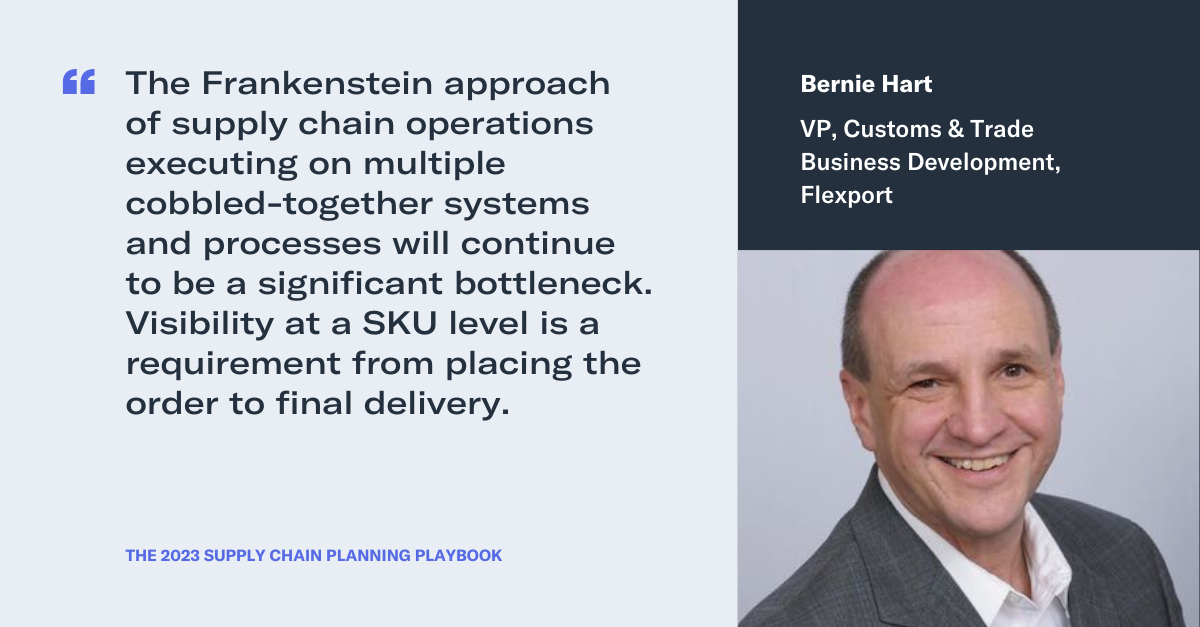
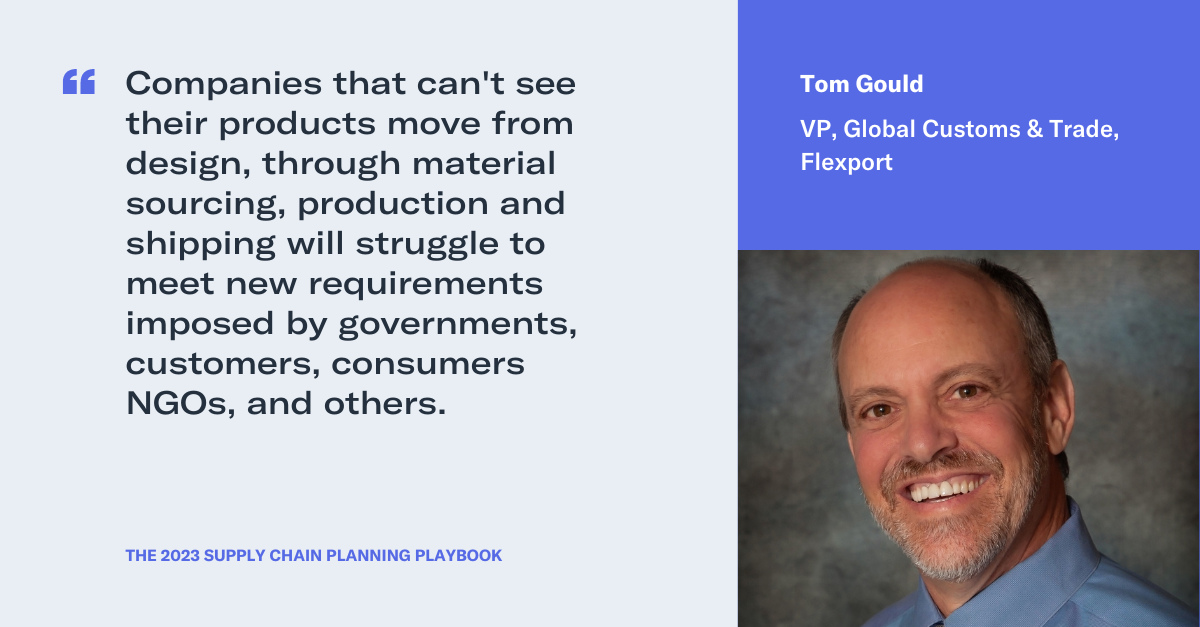
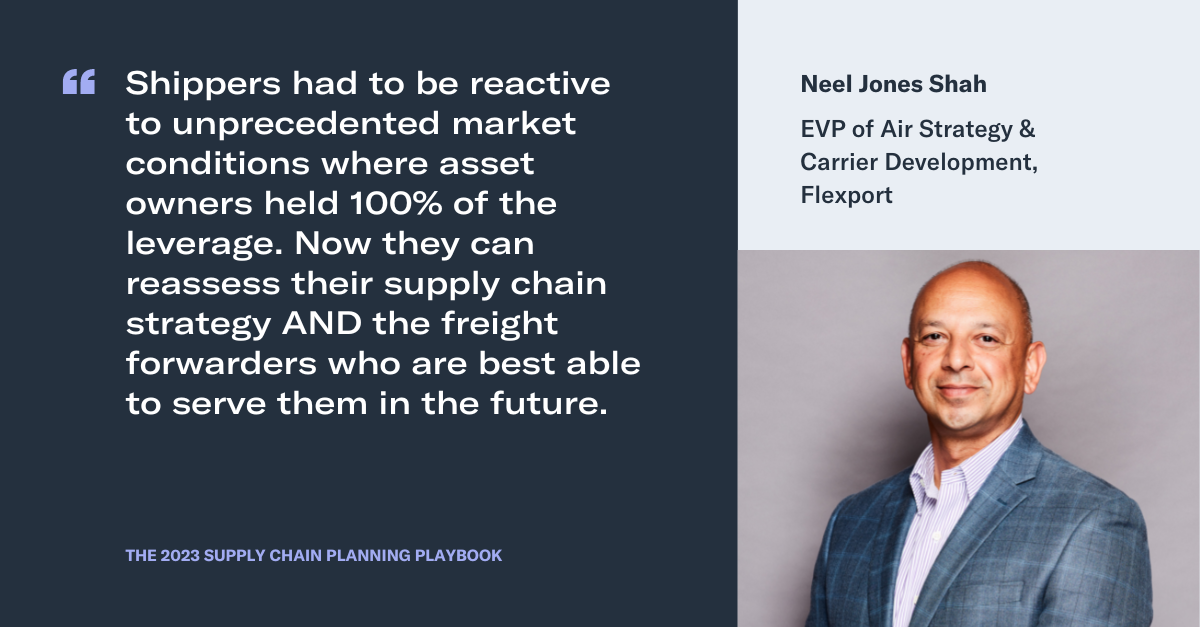
To best position your brand in a time of unpredictability, industry experts encourage prioritizing freight forwarding partners that bring technology-driven strategies and end-to-end solutions, all connected via an easy-to-use platform to help you ship, scale, insure, track, and deliver shipments—24x7.
2. Resilience is the Goal. Flexibility & Maximum Optionality are the Keys
Companies can optimize and increase resilience and profitability—and in turn their bottom lines—by redesigning their supply chains to be more flexible, agile, and responsive to market changes. Traditional planning approaches limit flexibility in global supply chains making it hard to respond quickly to changes in customer demand, market shifts, and economic downturns.
Leaders from multiple departments including operations, sales, sourcing, and marketing should get together with the logistics team regularly to set realistic goals and mitigate potential risks. This requires company-wide visibility into new and historical data and a deep understanding of the company’s supply chain capabilities, sales forecasts, and budgetary constraints.
"Shippers should prioritize the SIOP (Sales, Inventory, and Operations Planning) process to remain resilient to changing conditions, while improving customer service, profitability, and cash flow."
- Lisa Anderson, President, LMA Consulting Group, Inc.
True supply chain flexibility means you can easily adjust production levels, raw-material needs, and transportation modes to allow for quick pivots when the unexpected occurs. Supply chain professionals must be able to glean timely, business-critical insight from large volumes of data without having to increase headcount or overheads. Building this type of flexibility into your supply chains allows you to easily scale to meet the needs of your customers, suppliers, partners, and investors.
How easily can you implement event-triggered planning strategies, pivot production and manufacturing, warehousing locations, etc. to keep up with fluctuating market conditions?
"Consumers are repurposing spend due to inflation and recession fears. Logisticians should focus on restoring cash flow and margins, but also stay close to the market, predict the "repurposing of spending,” and plan for the right SKUs."
- Rohit Sathe, Chief Procurement Officer, Sunrise Medical
Identifying the right mix of shipping routes and methods to help you prevent delays is key to avoiding more stockouts and surpluses. Need something shipped in a hurry to hit peak season dates? Use air for your top SKUs, so you don’t sell out of your top products. Air Freight offers shipment-level GPS tracking, in-person escorts and geofencing, and the ability to course correct exceptions faster.
Make sure you work with a forwarder who can help you course correct, alongside your team, to rebook or resolve and reduce delays.
"Just because you can put all your cargo on one vessel/plane, doesn't mean you have to. Think of the impact if the worst case scenario occurs and you lose everything. How would that impact your business?"
- Scott Voorhees, Business Development Manager, Insurance, Flexport
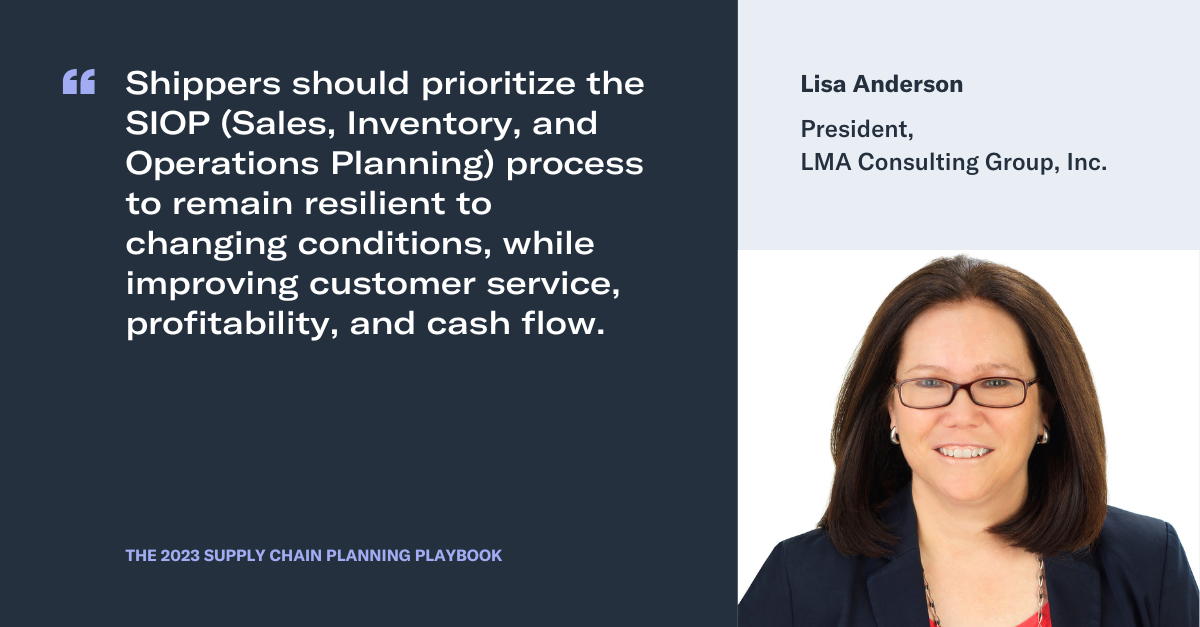


3. Supply Chain Data Isn’t Just for Logistics Teams
When companies have the technology and processes to enable cross-team collaboration, it helps them maximize supply chain efficiency and responsiveness. The data silos created by stakeholders in traditional supply chains—dominated by the use of spreadsheets and emails to communicate between teams—mean that there’s no easy way to get the overall picture of an order’s status. Suppliers might not send word of a shipment being ready until after it has left the factory, or you may be told the vessel is set to depart today but don’t get notified that it was actually held up for three days. Or your marketing team may launch a campaign promoting a new SKU that’s not actually going to make it to your warehouse in time due to an unexpected delay.
"It's hard to prepare for an event like a global pandemic, but if different teams are on the same page with streamlined workflows you can mitigate bottlenecks faster."
- Anders Schulze, VP & Global Head of Ocean Freight, Flexport
Flexport's internal data shows that as many as 25% of customer shipments are impacted by late or missing paperwork. Late or incorrect submission of documents, such as the Commercial Invoice, Packing List, and the House Bill of Lading will block or delay Customs clearance, and as a result, delay the final delivery to your warehouse or retail location. By tracking communication and documentation end-to-end, from supplier to customer, all in one place, you’re better positioned to work together to find ways to improve these processes.
"Everyone is struggling with uncertainty and trying to find a crystal ball. Companies that are properly positioned can benefit from unpredictable events, even while their competitors are being disrupted."
- Daniel Stanton, CEO & Chief Learning Officer, Mr. Supply Chain
This lack of cross-team data access can also impact the business in other ways. For example, lenders are increasingly requiring a lot more due diligence to offer financing to small businesses and without detailed reporting on the health of a brand’s supply chain, your finance team will find it almost impossible to secure cash flow in today’s lending market. A logistics platform and processes that allow for sharing of shipment data, declared values, customs filings, and more helps your finance team better position your brand for a loan with fast turnaround times. Your logistics team shouldn’t be the only team that has visibility into the health and inner workings of your global supply chain.
"If you are seeking funding, hone in on your corporate story regarding profitability or profitability potential, supported by high-quality financials and projections."
- Shahin Shafiei, Sr. Business Development Manager, Flexport
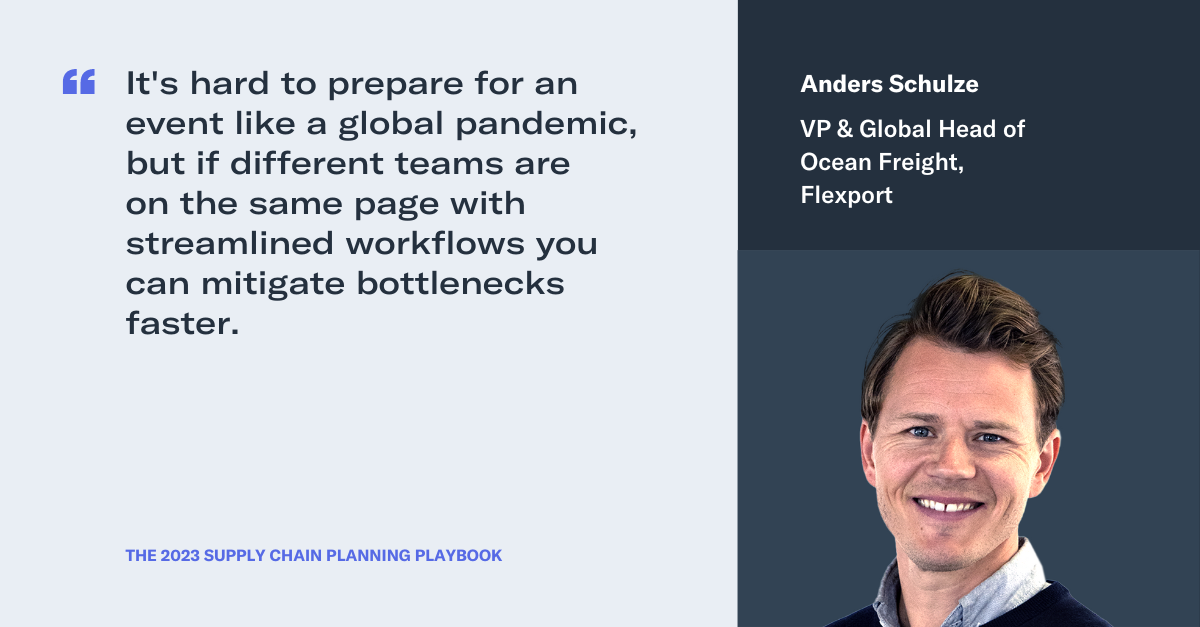
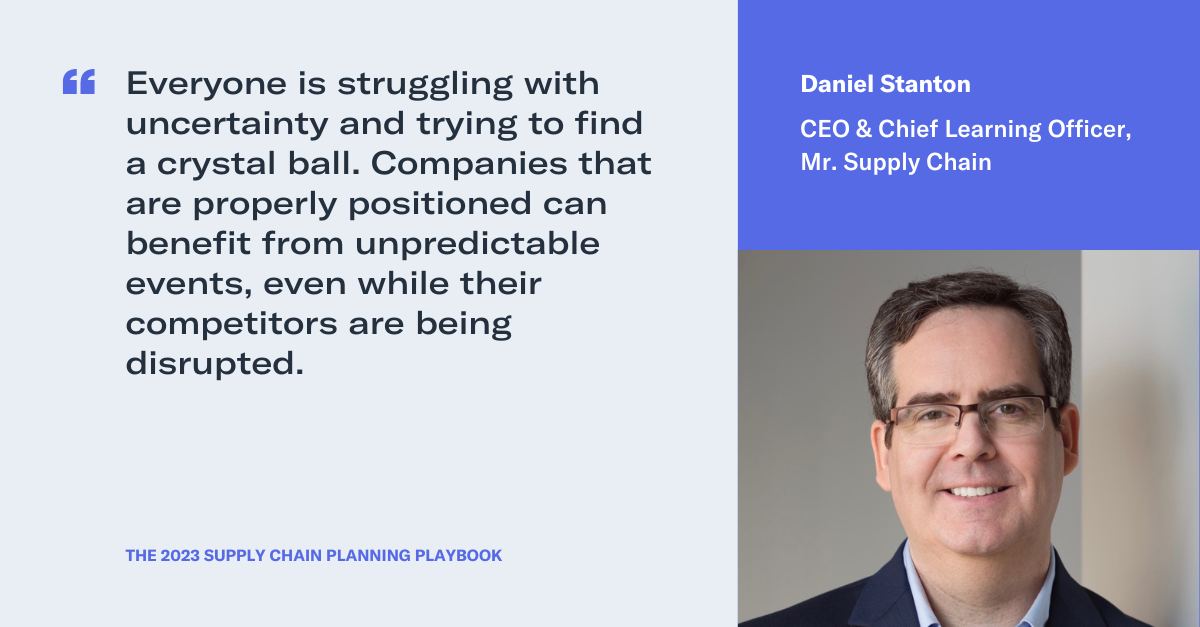

4. Better Demand Planning and Flexible Insurance for the Win
Brands are dealing with different sides of the same coin where they can’t strike the balance between too much and too little inventory. Either way, the common factor remains—retailers are not stocking the right quantity of the right products. Better demand and inventory planning tools are changing the game for brands as the global pandemic made it painfully obvious that traditional forecasting models weren’t good enough for these turbulent times.
"Executives realize they must gain better control over their end-to-end supply chain to serve customers, meet business objectives, and successfully navigate external conditions."
- Lisa Anderson, President, LMA Consulting Group, Inc.
Companies need better, faster, and more accurate ways to predict what comes next and to find creative ways to respond faster to shifts in demand and spending.
What does this mean for smaller e-commerce and retail businesses that don’t have abundant warehouse space to store next year’s inventory? In situations like these, experts recommend you start by addressing your business' forecasting accuracy.
"We tend to build our business plans around forecasts, and this is okay when things are relatively stable. But right now our supply chains seem to be unpredictable, so planning needs to consider multiple scenarios."
- Daniel Stanton, CEO & Chief Learning Officer, Mr. Supply Chain
There were many unavoidable and unpredictable incidents in supply chains over the last three years. With larger container ships, longer transit times, unpredictable pandemic lockdowns, cyber threats, and political turmoil, your goods are increasingly at risk. In Q4 of 2020 alone, two cargo ships experienced heavy weather and lost 1,900+ containers. In 2018-2019, there were 425 ship fires that led to cargo loss and damage.
"It's not a matter of IF unexpected loss or damage occurs, but when. I can not stress enough how important it is to be adequately prepared. Cargo insurance is a great start."
- Ryan Horrocks, Sr. Business Development Manager, Flexport
The issue isn’t how often it happens; it’s the financial impact of that event. If an entire season of goods is in one shipment, the loss could be devastating for your business. If you don't have a flexible insurance plan, your only recourse is carrier liability which is generally very limited. Spending a few hundred dollars now can potentially save you tens of thousands should the worst happen.
"Crises are a matter of when they happen, not if. Make sure you have great insurance providers that will ensure you are adequately covered and that will always have your best interests in mind."
- Scott Voorhees, Business Development Manager, Insurance, Flexport

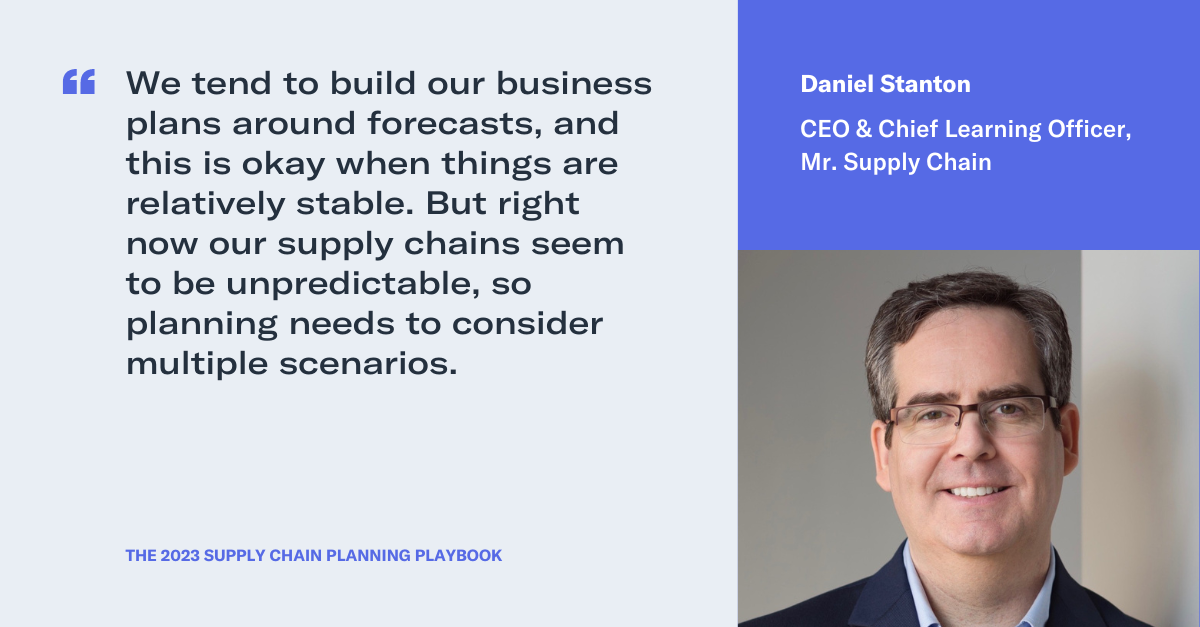

5. Brands Are in Savings Mode, Looking to Lower Total Landed Costs
The last three years have been a stressful, crazy rollercoaster ride for logistics professionals. First, inventories dropped to historic lows, which led to inconsistent product availability for online and in-person shoppers alike. Now, brands face stock overages with limited warehouse space and plummeting ocean shipping rates coupled with inflation and a steep decline in consumer spending.
"We have moved from an environment with 20% more demand than supply, to a new world where there’s 20% more supply than demand. This is a massive opportunity to save costs at every leg of the supply chain."
- Anders Schulze, VP & Global Head of Ocean Freight, Flexport
Logistics professionals wear many hats–all day, every day. Working as a CEO/COO/VP of Logistics/CXO/Head of Recruiting doesn’t leave a lot of time for actual logistics planning. And since supply chains have only gotten more complex and expensive, it’s important to wear all your hats to find ways to cut costs. Brands often narrow their focus to freight rates, overlooking other ways to save.
"There is a small, yet real chance of contagion which would lead to a severe recession. Plan to focus on cash management, but be careful about jeopardizing critical suppliers."
- Yossi Sheffi, Director, MIT Center for Transportation & Logistics
With current inflation rates and predictions for a long-term recession, it’s no surprise that businesses are taking a step back to reassess logistics operating costs, order management, and overall landed costs in 2023.
"With inflation, a rise in Customs & Border Protection enforcement efforts, and increased tariffs continuing for the foreseeable future, there is a heightened need for cost-saving measures."
- Tim Vorderstrasse, Head of Drawback, Flexport
Several brands are relying more on air freight in 2022 to stock up on high-demand SKUs, a strategic decision that’s more business-critical than cutting shipping costs. Instead, companies may benefit from selectively trimming expenses where possible, while refocusing capital where it can ensure long-term resilience and growth.
"Shippers will be well served to ask for shorter-term air freight rate validity, so they can take advantage of the spot market and not pay a hedge by securing longer-term validity in a highly volatile market."
- Neel Jones Shah, EVP of Air Strategy & Carrier Development, Flexport
There are other areas of savings that can help. For example, Duty Drawback is a great way to reclaim money for your business. This U.S. Customs program allows companies who export a portion of their sold products to receive huge refunds on tariffs.
"Prioritizing duty mitigation strategies like duty drawback by leveraging their historic transactions will help the profitability of companies and allow them to expand their global presence."
- Tim Vorderstrasse, Head of Drawback, Flexport
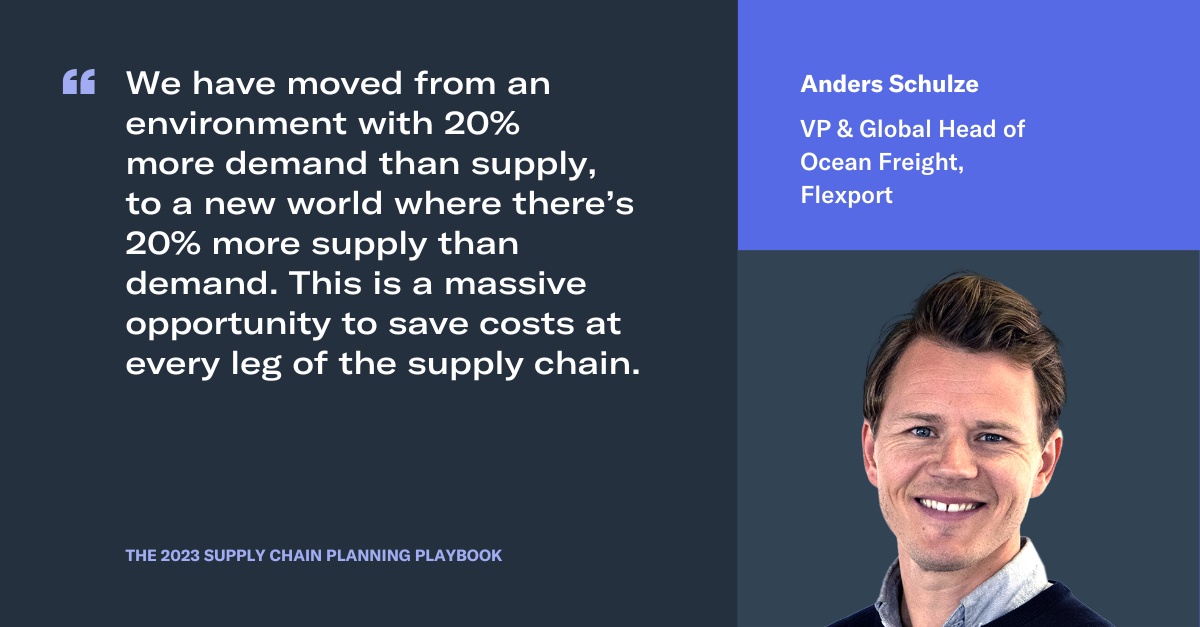
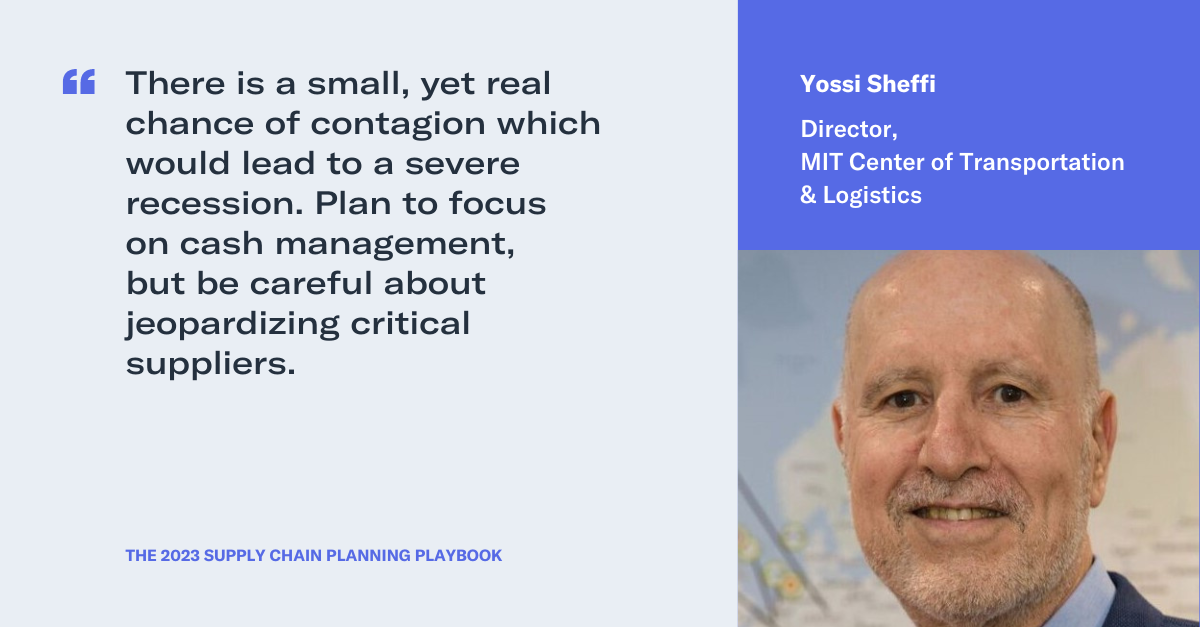

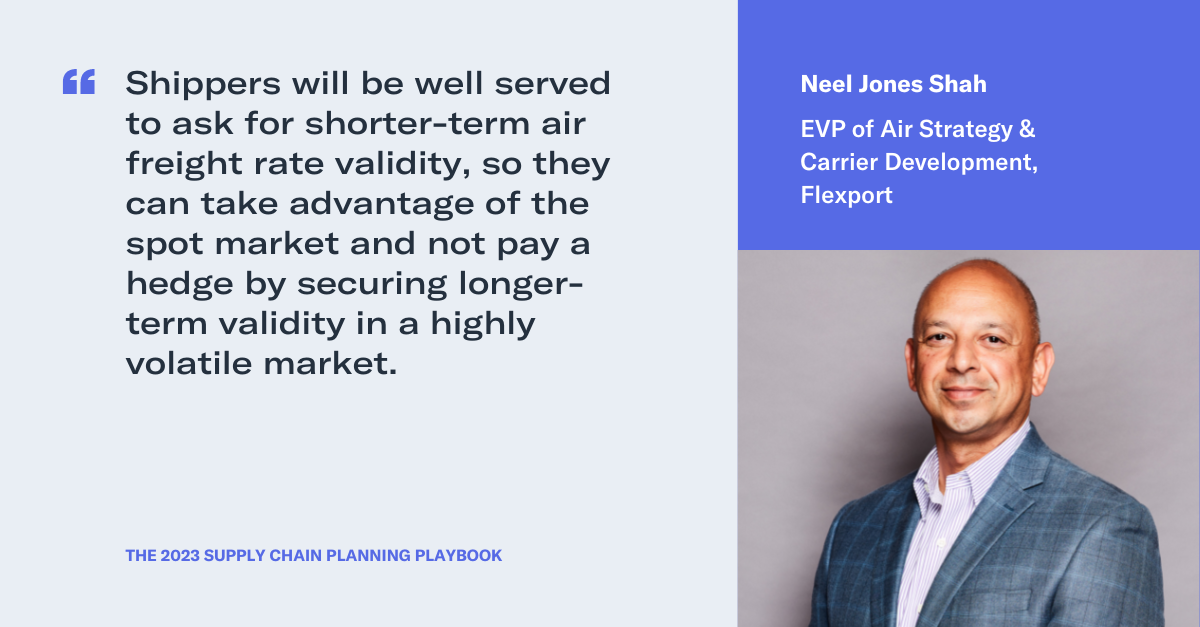
6. The Case for Nearshoring & Reshoring - Will This Reshape Trade?
The past few years have shown shippers how difficult it is to navigate unprecedented challenges that impact cross-border movement of materials and goods. Some brands are exploring nearshoring and reshoring to mitigate supply chain risks and respond faster to potential disruptions.
"If the last few years have taught us anything, it's to plan for the worst and work towards building a robust supply chain that can withstand regional and global crises. Now is an ideal time to move sourcing closer to home."
- Matt Koivisto, Director, North American Trucking Procurement, Flexport
According to a recent survey by ABB’s robotics and automation division, 70% of U.S. manufacturing companies plan to establish or relocate production capacity, their customers, or potential buyers closer to home. In a study from Kearney, 92% of executives express positive sentiments toward reshoring, and 79% of executives who have manufacturing operations in China have either already moved part of their operations to the United States or plan to do so in the next three years, and another 15% are evaluating similar moves.
"Shippers will try and diversify geopolitical risk by manufacturing in multiple locations and also make sure that at least some of their manufacturing base is close to their home markets."
- Neel Jones Shah, EVP of Air Strategy & Carrier Development, Flexport
What we’ve seen in reality is that the reshoring trend has been moving very slowly due to various hurdles brands need to overcome. Compared to other locations, Asian manufacturing hubs are still the most cost-effective in terms of production.
"Low levels of unemployment, high interest rates, high inflation, and the return to pre-pandemic freight costs will adversely affect the case for near or re-shoring."
- Rohit Sathe, Chief Procurement Officer, Sunrise Medical
In addition to the cost factor, moving manufacturing or tier 1 supplier relationships closer to home may not increase resiliency. Ultimately, shippers still have to balance costs with other dependencies and supplier expertise in their end-to-end supply chain network.
"The main trend for 2023 focuses on developing trading blocs with supply chains across China, Europe and North America, while regions including Latin America and the rest of Asia are likely to trade with everyone."
- Yossi Sheffi, Director, MIT Center for Transportation & Logistics
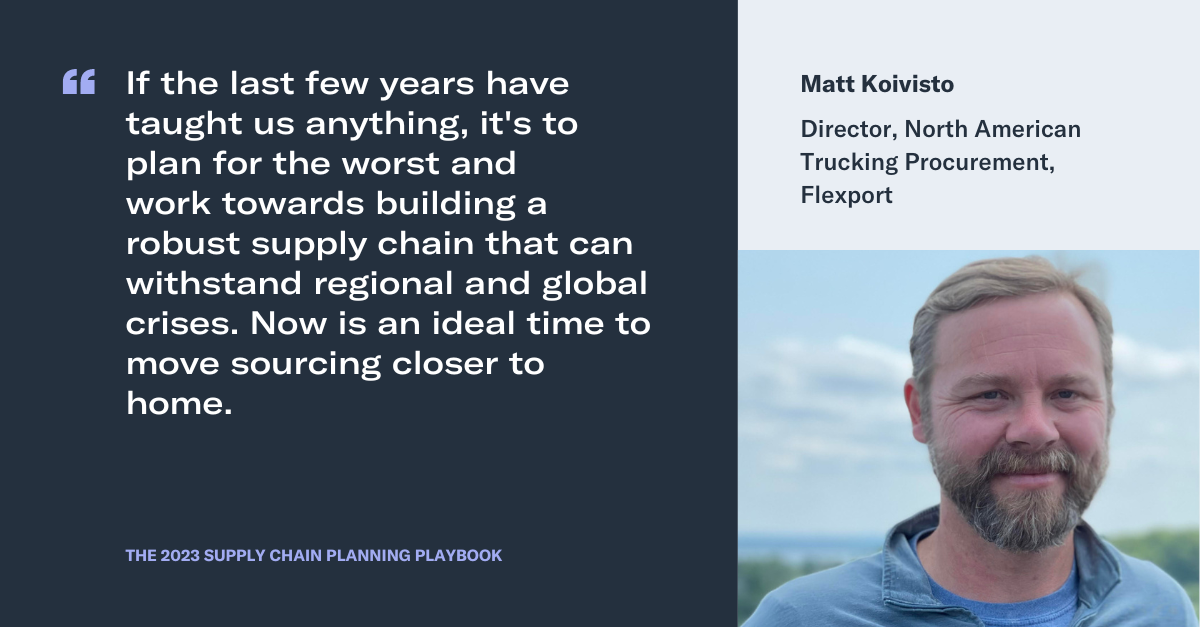

7. The Biggest Challenge and Opportunity for Brands is Visibility
Every segment of the global supply chain has taken a hit over the last couple of years. If it wasn’t port labor issues, it was the Suez Canal blockage. And if it wasn’t the delays caused by the COVID lockdown, it was consumer demand for goods over services that surged in 2021 driving an unprecedented volume of shipments, port congestion, and significant delays across every step of the supply chain.
"The biggest logistics challenge or opportunity for brands in 2023 is visibility. Both supply chain visibility as finished products move from shipper to importer, and product traceability ‘from dirt to shirt’."
- Tom Gould, VP, Global Customs & Trade, Flexport
Investing in a logistics tech platform/stack that enables you to make confident decisions–and that can grow with your business–is now a must-have for shippers. In an industry dominated by spreadsheets, emails, and phone calls, it’s challenging for a small business or e-commerce company to stay on top of keeping SKUs in stock and keeping customers up-to-date on their order status. You need real-time data and visibility into every step of your supply chain—from purchase order to final delivery—so you can make decisions even after your goods are en route.
"Companies must know their predictive landed cost at a product level, calculate actual landed cost, and be empowered to work the variance. Exporters and importers with SKU-level info that can be easily shared and maintained via supply chain partners will be well positioned."
- Bernie Hart, VP, Customs & Trade Business Development, Flexport
Small businesses polled by Gartner cite “enhanced decision-making potential” as a driving factor in supply chain technology investment. For example, the ability to access self-service data on transit times with only a few clicks can help your team plan which route and/or mode to use for which SKUs. The increased complexity of modern supply chains also calls for better analytics to help you stay in front of future unknowns.
"The future of supply chains will feature a market and customer-driven necessity to evaluate and mitigate risks. Utilizing increasingly sophisticated software from third-party providers can help you achieve this… Do all you can to identify all potential risks associated with sourcing, production, and shipping. Develop contingency plans to mitigate problems effectively and in a timely fashion."
- Harold (Hal) Good, President & CEO, Procurement Pros Group, LLC
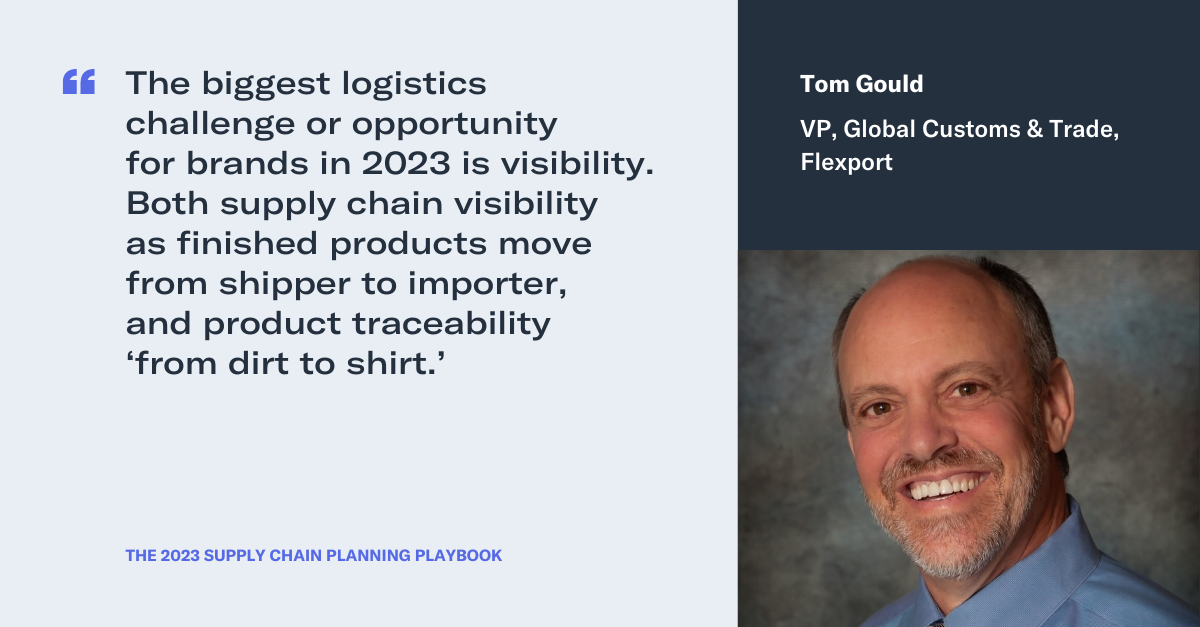
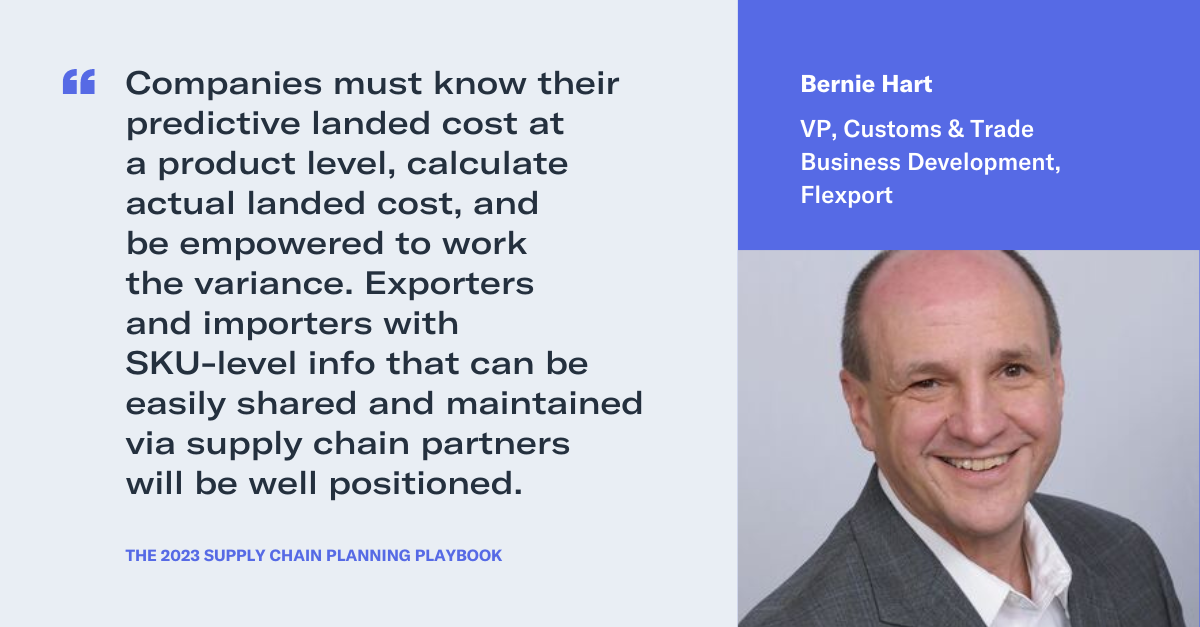
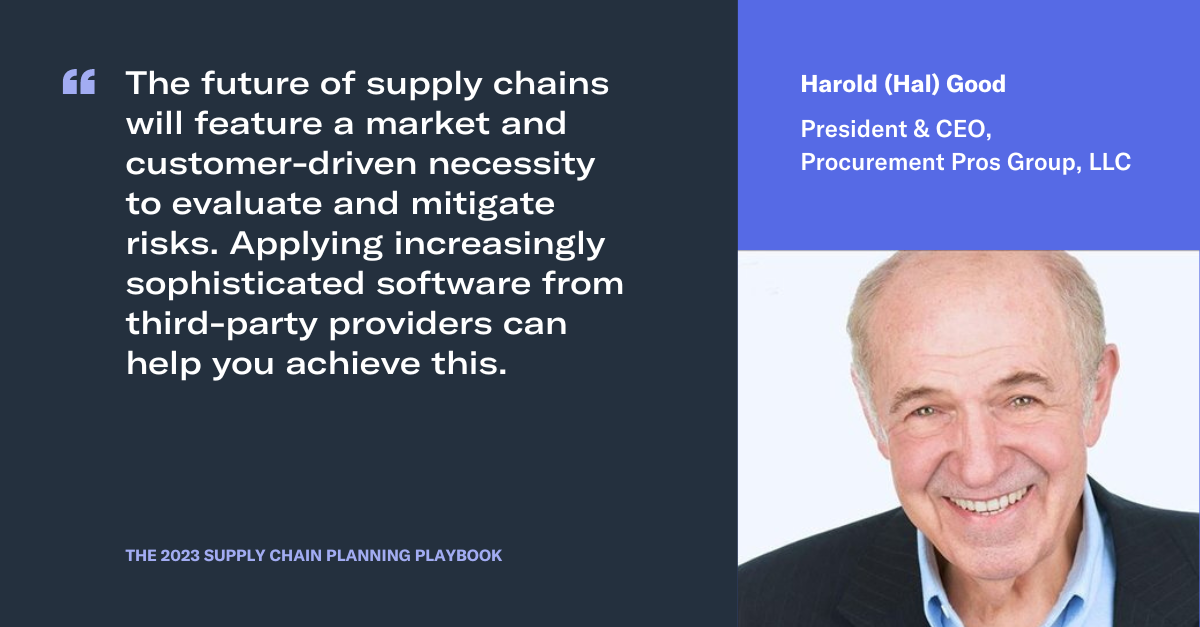
8. Sustainability is Now a “Must Have” for Supply Chain Leaders
For businesses of every size, the need to make real strides toward a more sustainable supply chain has never been more pressing. Climate change and its ties to shipping and the retail industry are well-known. There is a fundamental shift in millennials’ preference toward eco-conscious brands. This cohort wields more spending power than any before it, and they’re buying according to their values.
By 2030, the collective income of millennials worldwide is expected to top $4 trillion. 75% of them consider it important that a brand gives back to society, and 52% say they’ll be loyal to brands that align with their values.
New and upcoming legislation is also shifting towards further transparency and responsibility. Multiple legislative changes in the U.S. now require some brands to start tracing and reporting the climate and social impacts of their supply chains and other operations. This is changing the way businesses account for supply chain transparency and responsibility, and more states may follow suit.
Stay Keen on Going Green - Prioritize Sustainability
While every organization’s emissions footprint will look a bit different, a rough breakdown may include:
- Transportation/logistics (including upstream and last mile)
- Manufacturing (rethink the production process of goods)
- Packaging (can you use more recyclable, reusable, reduced weight packaging, etc.?)
- Energy efficiency (in all owned buildings including offices, warehouses, retail stores, etc.)
"Even though much progress and investment is being made on renewables and alternate sources of energy, there is a significant gap in timing, technology, and practical solutions supporting the end-to-end supply chain carbon footprint."
- Lisa Anderson President, LMA Consulting Group, Inc.
Ultimately, net zero planning needs to be bigger than carbon neutrality, including a reduction of all greenhouse gas emission types. The component of reducing impact, rather than just offsetting it, is what makes this approach different. For shippers, there are competing interests. Moving cargo quickly and reliably is key to business stability and growth, but there’s no such thing as greenhouse gas-free shipping yet, so companies need to be intentional about climate impact.
A rising industry expectation that will shape the future of shipping is supply chain “circularity,” which focuses on squeezing out every bit of value from materials and resources. This approach forces brands to dramatically shift their strategy from a linear one-time use of materials to an indefinitely looped life cycle by connecting waste and by-products from various processes to other raw material needs.
"The demand for circular, cleaner supply chains is rising. Exporters must collaborate extensively with customers to explore "circularity" last-mile solutions like reusing and repurposing to optimize the carbon footprint of supply chains."
- Rohit Sathe, Chief Procurement Officer, Sunrise Medical
In a more circular supply chain landscape, there will be a huge influx and growth of maintenance, refurbishment, and remanufacturing companies. Experts predict that our global economy will accelerate the worldwide shift from linear to circular supply chains.
"Committing to the circular economy will present great opportunities in capturing value from materials and costs, improving productivity, designing for durability, and embracing technologies - all of which are good for the planet and your brand."
- Darshana Rajaram, Head of Partner Network Development, Flexport

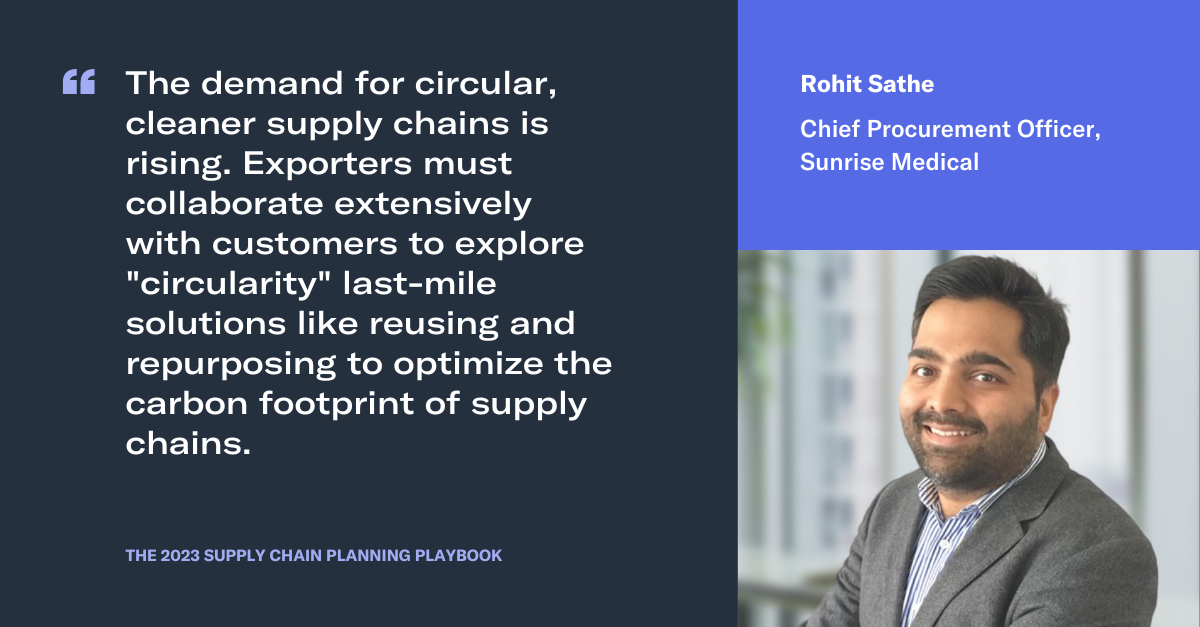
9. Supply Chain Automation Technologies Are Here to Stay
For over a decade now, sellers, 3PLs, freight forwarders, manufacturers, and ports have been increasing their use of AI, Robotic Process Automation (RPA), and warehouse robots to make supply chains safer and more efficient. A 2022 survey by the B2B magazine Modern Materials Handling reported that 53% of survey respondents said that spending on automation and systems will increase this year.
"Tomorrow's supply chains will look much more sophisticated as executive leaders learn from being unprepared during the pandemic and will prioritize investments in better technology, talent, and infrastructure."
- Zeid Houssami, VP & Global Head of Air Freight, Flexport
Dealing with labor shortages was one of the key drivers of automation investments. Other drivers include labor-intensive processes of filling e-commerce orders and tighter fulfillment cycle times.
"As complexity in supply chains continues to increase, the need for automation and technology will further grow exponentially. Be ready for it!"
- Paul Rombeek, Senior Director Network Trade Lane Management EMEA, Flexport
Supply chain automation tools can help companies improve decision-making, reduce costs, increase accuracy, and speed up delivery times.
"The future of supply chains will be equal parts movement of goods and the data representing them and our collective ability to aggregate, understand, translate, and report on that data through automation at scale."
- Tim Vorderstrasse, Head of Drawback, Flexport
The adoption of supply chain automation technologies continue to augment the efforts of human workers–but not replace them. Industries like automotive, manufacturing, retail, and food and beverage production have had a difficult time hiring and retaining qualified workers. Supply chain automation tech can help address issues like that.
"Technology development will enable knowledge networks and connected ecosystems - this will drive the simplification of supply chains."
- Darshana Rajaram, Head of Partner Network Development, Flexport
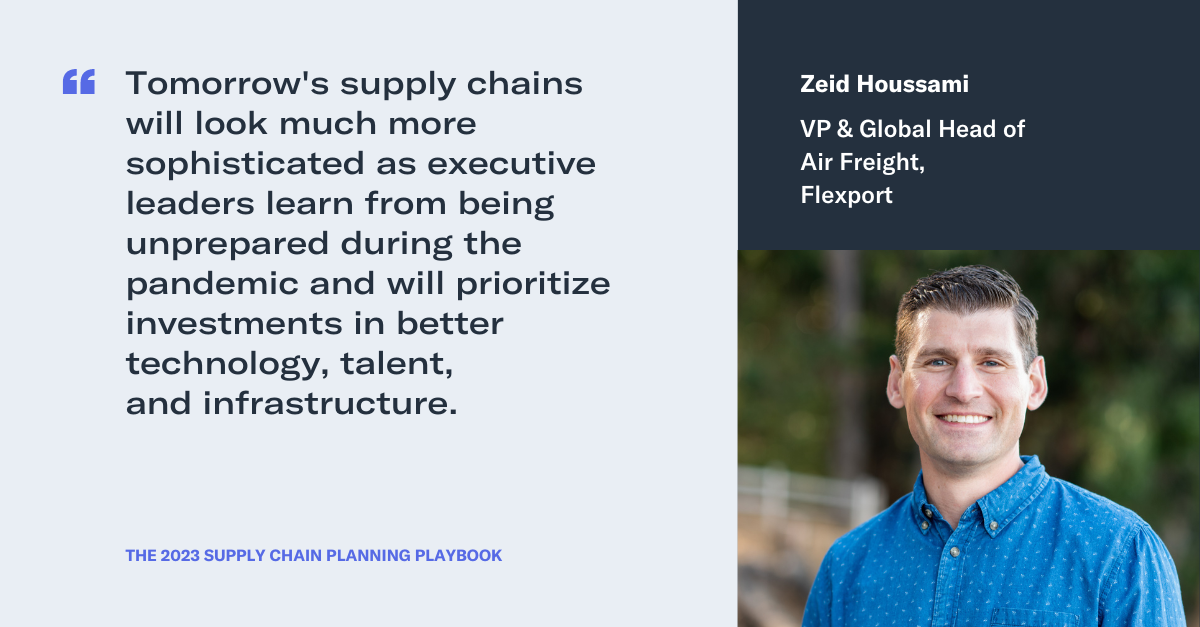
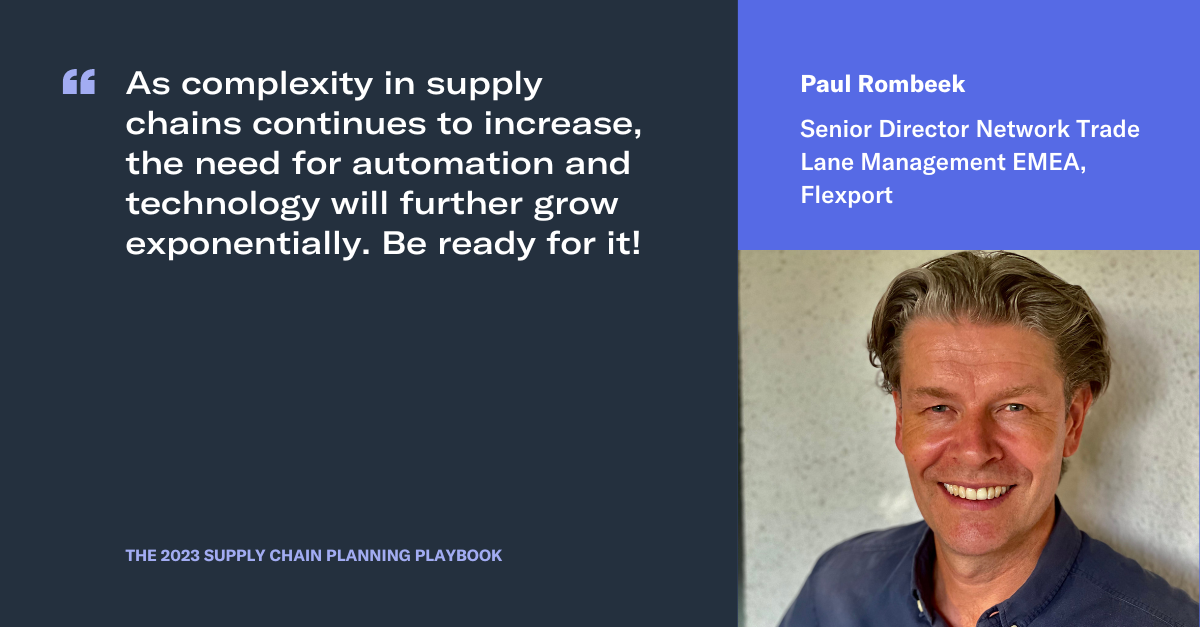
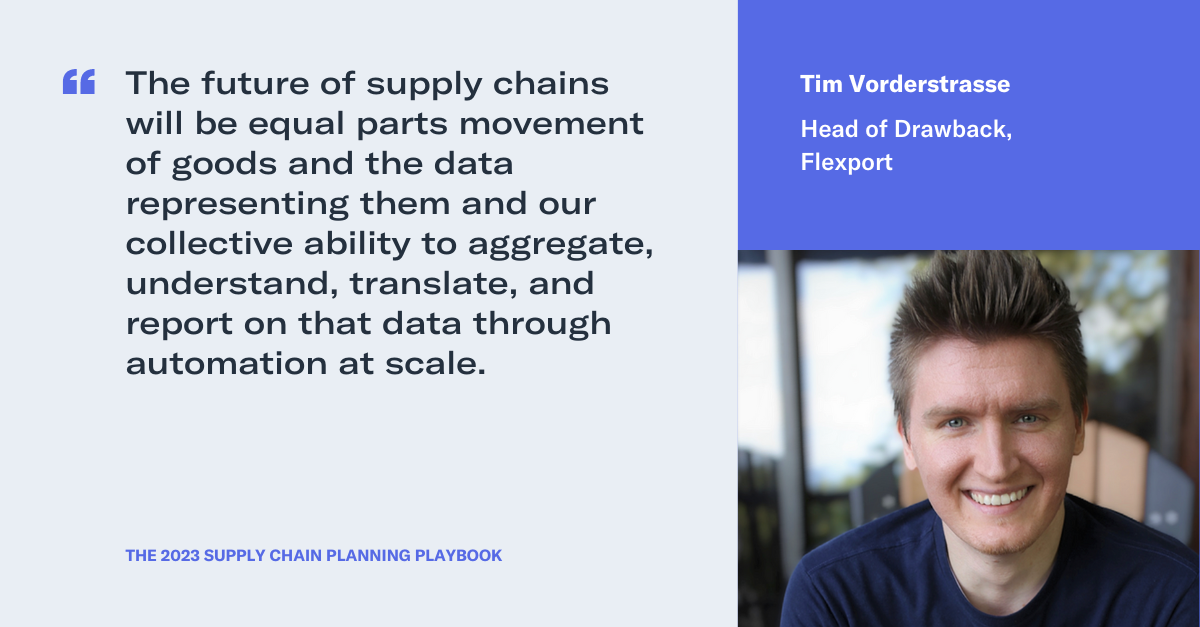
10. Playing The Long Game Will Be Your Competitive Advantage
Today’s supply chain leaders know that the incremental improvements and investments they make when aligned with company goals, employee productivity, and customer satisfaction can make a huge difference in the long term health of a business. Long-term commitment through scalable technology platforms and like-minded partners can help brands drive both growth and competitive advantages.
"Ultimately, brands should seek partners who understand global trade and the most pressing problems they face today."
- Shahin Shafiei, Sr. Business Development Manager, Flexport
A digital logistics ecosystem that enables easier collaboration for all stakeholders, partners, suppliers, and forwarders can drive improvements by capturing real-time product availability, tracking demand and supply data, increasing the efficiency of employees, and improving customer loyalty—all of which contributes to growth and profitability.
"While 2021 can be considered a year of “do what it takes to get inventory,” I think 2023 can be used to prepare supply chains for the next black swan event… Shippers that win long-term will continue to balance strong partnerships by challenging logistics providers to offer market competitive rates, while also maintaining those relationships for the long haul."
- Zeid Houssami, VP & Global Head of Air Freight, Flexport
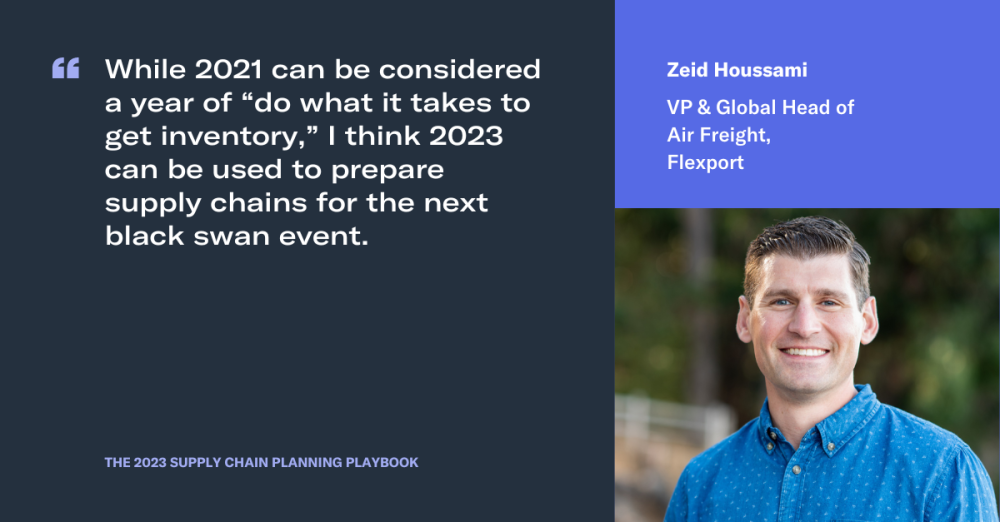
'Tis the Season to Future-Proof Your Supply Chain
Despite the uncertainties that lie ahead, there are several ways to prepare your supply chain for 2023 and beyond. If you’re a fast-growth brand looking to stay ahead of demand and market conditions, our Smart Commerce Newsletter has you covered. Sign up here for a monthly dose of inspiration, expert perspectives, ecommerce trends, and advice from kick-ass product-led brands.
Learn more about how Flexport can help you keep your shelves stocked and customers happy with end-to-end supply chain visibility, agility, and efficiency.



